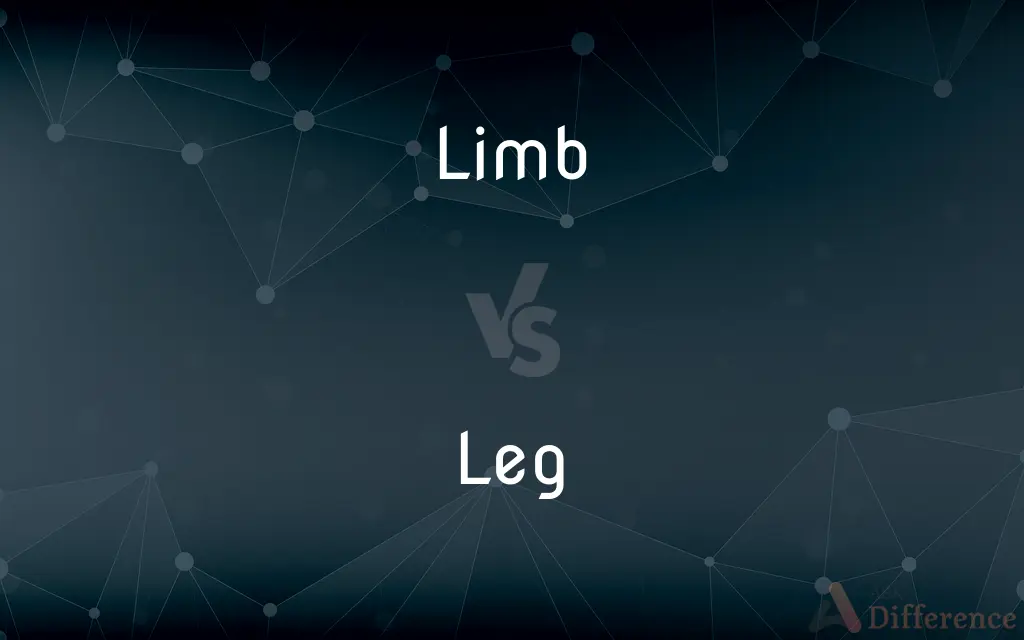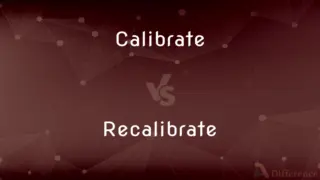Limb vs. Leg — What's the Difference?
By Tayyaba Rehman & Maham Liaqat — Updated on March 26, 2024
Limb refers to a large branch of a tree or any of the arms or legs of a human or animal, while leg specifically denotes the lower limb of a human or animal, used for support and locomotion.

Difference Between Limb and Leg
Table of Contents
ADVERTISEMENT
Key Differences
A limb encompasses more than just the human or animal appendages used for movement and manipulation; it also includes large branches of trees, highlighting its broader application in language. In contrast, a leg is specifically one of the two lower extremities in humans and animals that include the foot, ankle, calf, knee, and thigh, primarily used for standing, walking, and running, underscoring its specific biological and functional role.
Limb serves as a generic term that can apply to both arms and legs in humans and their equivalents in animals, emphasizing the concept of appendages without specifying function. This term allows for a wide range of applications, from describing parts of living organisms to components of inanimate objects (e.g., limbs of a chair). On the other hand, the leg is distinctly recognized for its role in support and movement, integral to the anatomy of bipeds and quadrupeds, indicating its exclusive association with locomotion.
In medical and anatomical contexts, the distinction becomes more pronounced. Limb is used to refer to both upper and lower extremities, covering a broad spectrum of health issues, treatments, and prosthetics, without specifying whether the arm or leg is involved. Legs, however, are the focus of specific studies and medical practices, such as orthopedics and podiatry, which deal with their structure, function, and disorders, highlighting a specialized focus within healthcare.
From an evolutionary perspective, limbs in animals have adapted over millions of years for various functions, including manipulation, locomotion, and even signaling. Legs are a subset of limbs that have evolved specifically for support and movement, demonstrating the adaptive nature of biological structures to environmental and survival challenges.
In everyday language, the term limb is often used metaphorically to describe taking a risk ("going out on a limb"), whereas leg does not commonly share this figurative application. This difference illustrates how limb, with its broader meanings, lends itself to a wider array of expressions and interpretations, while leg remains closely tied to its physical and functional attributes.
ADVERTISEMENT
Comparison Chart
Definition
An appendage of the body; a large branch
The lower extremity of the body used for movement
Application
Humans, animals, trees
Specifically humans and animals
Function
General term for appendages; can include non-supportive roles
Primarily for support and locomotion
Medical Context
Broadly relates to upper and lower extremities
Focuses on structure, function, and disorders of lower extremity
Evolutionary Perspective
Adaptations for various functions
Evolved specifically for support and movement
Metaphorical Use
Common ("going out on a limb")
Less common
Specificity
General term
Specific to locomotion
Compare with Definitions
Limb
Generic appendage.
The monkey used its limbs to swing from tree to tree.
Leg
Specific to locomotion.
The table's leg was wobbly and needed repair.
Limb
Includes arms and legs.
Limb loss can significantly impact quality of life.
Leg
Anatomical focus.
Leg muscles are crucial for running and jumping.
Limb
Broad application.
After the storm, several limbs fell from the oak tree.
Leg
Lower extremity.
She broke her leg skiing last winter.
Limb
Metaphorical use.
He went out on a limb to defend his theory.
Leg
Orthopedic studies.
Orthopedists specialize in treating leg injuries.
Limb
Evolutionary diversity.
The limbs of different animals have evolved for various functions.
Leg
No metaphorical use.
The project stands on its own legs, meaning it's independently viable.
Limb
One of the larger branches of a tree.
Leg
A leg is a weight-bearing and locomotive anatomical structure, usually having a columnar shape. During locomotion, legs function as "extensible struts".
Limb
One of the jointed appendages of an animal, such as an arm, leg, wing, or flipper, used for locomotion or grasping.
Leg
Each of the limbs on which a person or animal walks and stands
He was off as fast as his legs would carry him
Adams broke his leg
A leg injury
Limb
An extension or a projecting part, as of a building or mountain range.
Leg
Each of the supports of a chair, table, or other structure
The house was set on legs
Table legs
Limb
An extension or part distinguished from the main body or group
The conservative limb of the party.
Leg
A section or stage of a journey or process
The return leg of his journey
Limb
A member or representative of a group
Was arrested by a burly limb of the law.
Leg
A branch of a forked object.
Limb
(Archaic)An impish child.
Leg
The half of the field (as divided lengthways through the pitch) away from which the batsman's feet are pointed when standing to receive the ball
He played a lucky stroke to leg
Limb
(Astronomy)The circumferential edge of the apparent disk of a celestial body.
Leg
A deferential gesture made by drawing back one leg and bending it while keeping the front leg straight.
Limb
(Mathematics)The edge of a graduated arc or circle used in an instrument to measure angles.
Leg
Travel by foot; walk
I am part of a team legging it around London
Limb
(Botany)The expanded tip of a plant organ, such as a petal or corolla lobe.
Leg
Propel (a boat) through a tunnel on a canal by pushing with one's legs against the tunnel roof or sides
A little boy was lying on his back, legging the boat along
Limb
To remove the branches from.
Leg
One of the limbs or appendages that an animal uses for locomotion or support.
Limb
A major appendage of human or animal, used for locomotion (such as an arm, leg or wing).
Leg
One of the lower or hind limbs in humans and other primates.
Limb
A branch of a tree.
Leg
The part of the limb between the knee and foot in vertebrates.
Limb
(archery) The part of the bow, from the handle to the tip.
Leg
The back part of the hindquarter of a meat animal.
Limb
An elementary piece of the mechanism of a lock.
Leg
A supporting part resembling a leg in shape or function.
Limb
A thing or person regarded as a part or member of, or attachment to, something else.
Leg
One of the branches of a forked or jointed object.
Limb
(astronomy) The apparent visual edge of a celestial body.
The solar limb
Leg
The part of a garment, especially of a pair of pants, that covers the leg.
Limb
(on a measuring instrument) The graduated edge of a circle or arc.
Leg
(Mathematics) Either side of a right triangle that is not the hypotenuse.
Limb
(botany) The border or upper spreading part of a monopetalous corolla, or of a petal or sepal; blade.
Leg
(Nautical) The distance traveled by a sailing vessel on a single tack.
Limb
(transitive) To remove the limbs from (an animal or tree).
They limbed the felled trees before cutting them into logs.
Leg
The part of an air route or a flight pattern that is between two successive stops, positions, or changes in direction.
Limb
(transitive) To supply with limbs.
Leg
One of several contests that must be successfully completed in order to determine the winner of a competition.
Limb
A part of a tree which extends from the trunk and separates into branches and twigs; a large branch.
Leg
(Sports) One stretch of a relay race.
Limb
An arm or a leg of a human being; a leg, arm, or wing of an animal.
A second Hector for his grim aspect,And large proportion of his strong-knit limbs.
Leg
Legs The narrow streams of swirled wine or spirits that run slowly down along the inside of a glass, often believed to indicate that the liquid is full-bodied.
Limb
A thing or person regarded as a part or member of, or attachment to, something else.
That little limb of the devil has cheated the gallows.
Leg
Legs(Slang) The ability to last or sustain success, especially by appealing to an audience
A blockbuster movie that has legs.
Limb
An elementary piece of the mechanism of a lock.
Leg
To go on foot; walk or run. Often used with the indefinite it
Because we missed the bus, we had to leg it across town.
Limb
A border or edge, in certain special uses.
Leg
A limb or appendage that an animal uses for support or locomotion on land.
Insects have six legs.
Limb
To supply with limbs.
Leg
In humans, the lower limb extending from the groin to the ankle.
Dan won't be able to come to the party, since he broke his leg last week and is now on crutches.
Limb
To dismember; to tear off the limbs of.
Leg
(anatomy) The portion of the lower limb of a human that extends from the knee to the ankle.
Limb
One of the jointed appendages of an animal used for locomotion or grasping: arm; leg; wing; flipper
Leg
A part of garment, such as a pair of trousers/pants, that covers a leg.
The left leg of these jeans has a tear.
Limb
Any of the main branches arising from the trunk or a bough of a tree
Leg
A rod-like protrusion from an inanimate object, such as a piece of furniture, supporting it from underneath.
The legs of a chair or table
Limb
(astronomy) the circumferential edge of the apparent disc of the sun or the moon or a planet
Leg
(figurative) Something that supports.
This observation is an important leg of my argument.
Limb
Either of the two halves of a bow from handle to tip;
The upper limb of the bow
Leg
A stage of a journey, race etc.
After six days, we're finally in the last leg of our cross-country trip.
Limb
Any projection that is thought to resemble an arm;
The arm of the record player
An arm of the sea
A branch of the sewer
Leg
(nautical) A distance that a sailing vessel does without changing the sails from one side to the other.
Leg
(nautical) One side of a multiple-sided (often triangular) course in a sailing race.
Leg
(sports) A single game or match played in a tournament or other sporting contest.
Leg
(geometry) One of the two sides of a right triangle that is not the hypotenuse.
Leg
(geometry) One of the branches of a hyperbola or other curve which extend outward indefinitely.
Leg
The ability of something to persist or succeed over a long period of time.
This proposal has no legs. Almost everyone opposes it.
Leg
A disreputable sporting character; a blackleg.
Leg
An extension of a steam boiler downward, in the form of a narrow space between vertical plates, sometimes nearly surrounding the furnace and ash pit, and serving to support the boiler; called also water leg.
Leg
In a grain elevator, the case containing the lower part of the belt which carries the buckets.
Leg
Denotes the half of the field on the same side as the batsman's legs; the left side for a right-handed batsman.
Ponsonby-Smythe hit a thumping drive through the leg fielders.
Leg
(telephony) A branch or lateral circuit connecting an instrument with the main line.
Leg
(electrical) A branch circuit; one phase of a polyphase system.
Leg
(finance) An underlying instrument of a derivatives strategy.
Leg
An army soldier assigned to a paratrooper unit who has not yet been qualified as a paratrooper.
Leg
(archaic) A gesture of submission; a bow or curtsey. Chiefly in phrase make a leg.
Leg
(journalism) A column, as a unit of length of text as laid out.
Leg
To remove the legs from an animal carcass.
Leg
To build legs onto a platform or stage for support.
Leg
To put a series of three or more options strikes into the stock market.
Leg
To apply force using the leg (as in 'to leg a horse').
Leg
Alternative spelling of leg.
Leg
A limb or member of an animal used for supporting the body, and in running, climbing, and swimming; esp., that part of the limb between the knee and foot.
Leg
That which resembles a leg in form or use; especially, any long and slender support on which any object rests; as, the leg of a table; the leg of a pair of compasses or dividers.
Leg
The part of any article of clothing which covers the leg; as, the leg of a stocking or of a pair of trousers.
Leg
A bow, esp. in the phrase to make a leg; probably from drawing the leg backward in bowing.
He that will give a cap and make a leg in thanks for a favor he never received.
Leg
A disreputable sporting character; a blackleg.
Leg
The course and distance made by a vessel on one tack or between tacks.
Leg
An extension of the boiler downward, in the form of a narrow space between vertical plates, sometimes nearly surrounding the furnace and ash pit, and serving to support the boiler; - called also water leg.
Leg
The case containing the lower part of the belt which carries the buckets.
Leg
A fielder whose position is on the outside, a little in rear of the batter.
Leg
Either side of a triangle distinguished from the base or, in a right triangle, from the hypotenuse; also, an indefinitely extending branch of a curve, as of a hyperbola.
Leg
A branch or lateral circuit connecting an instrument with the main line.
Leg
A branch circuit; one phase of a polyphase system.
Leg
To use as a leg, with it as object
Leg
A human limb; commonly used to refer to a whole limb but technically only the part between the knee and ankle
Leg
A structure in animals that is similar to a human leg and used for locomotion
Leg
One of the supports for a piece of furniture
Leg
A part of a forked or branching shape;
He broke off one of the branches
They took the south fork
Leg
The limb of an animal used for food
Leg
A prosthesis that replaces a missing leg
Leg
Cloth covering consisting of the part of a garment that covers the leg
Leg
(nautical) the distance traveled by a sailing vessel on a single tack
Leg
A section or portion of a journey or course;
Then we embarked on the second stage of our Caribbean cruise
Common Curiosities
Are limbs only found in animals?
No, limbs can also refer to large branches of trees, extending its application beyond just the biological.
Can limbs have other meanings outside of biology?
Yes, limbs can metaphorically describe taking risks, and they are also used to refer to parts of objects, such as furniture.
Can the term limb be used interchangeably with leg?
Not in specific contexts; limb refers to both arms and legs, while leg is specific to the lower extremity used for movement.
How do prosthetics address the needs of limb vs. leg loss?
Prosthetics are tailored to replace the specific functions lost with each type of extremity, with leg prosthetics focusing on restoring mobility and limb prosthetics (including arms) on replacing grasping or reaching abilities.
Can both limbs and legs be subjects in art and design?
Yes, both can be depicted in art for various symbolic and aesthetic purposes, and in design, their structural aspects are often considered for creating ergonomic and functional objects.
Is the functionality of limbs and legs affected similarly by diseases?
Diseases can affect limbs and legs differently, depending on the condition's nature and the specific functions of the extremities involved.
What distinguishes a leg from an arm in medical terms?
A leg is designed for support and locomotion, with specific structures like the thigh, knee, and foot, while an arm is intended for manipulation and has its unique components such as the shoulder, elbow, and hand.
Why is it important to differentiate between limb and leg?
The differentiation is crucial for accurate communication in healthcare, biology, and everyday language, ensuring clarity in description and discussion.
What role do legs play in the evolution of species?
Legs have played a critical role in the evolution of many species, enabling adaptations for running, jumping, or swimming, contributing to survival and reproductive success.
How does the concept of limb contribute to understanding anatomy?
The concept of limb provides a broad understanding of the body's appendages, allowing for a comprehensive study of their development, function, and role in overall physiology.
Share Your Discovery

Previous Comparison
Kind vs. Thoughtful
Next Comparison
Calibrate vs. RecalibrateAuthor Spotlight
Written by
Tayyaba RehmanTayyaba Rehman is a distinguished writer, currently serving as a primary contributor to askdifference.com. As a researcher in semantics and etymology, Tayyaba's passion for the complexity of languages and their distinctions has found a perfect home on the platform. Tayyaba delves into the intricacies of language, distinguishing between commonly confused words and phrases, thereby providing clarity for readers worldwide.
Co-written by
Maham Liaqat














































